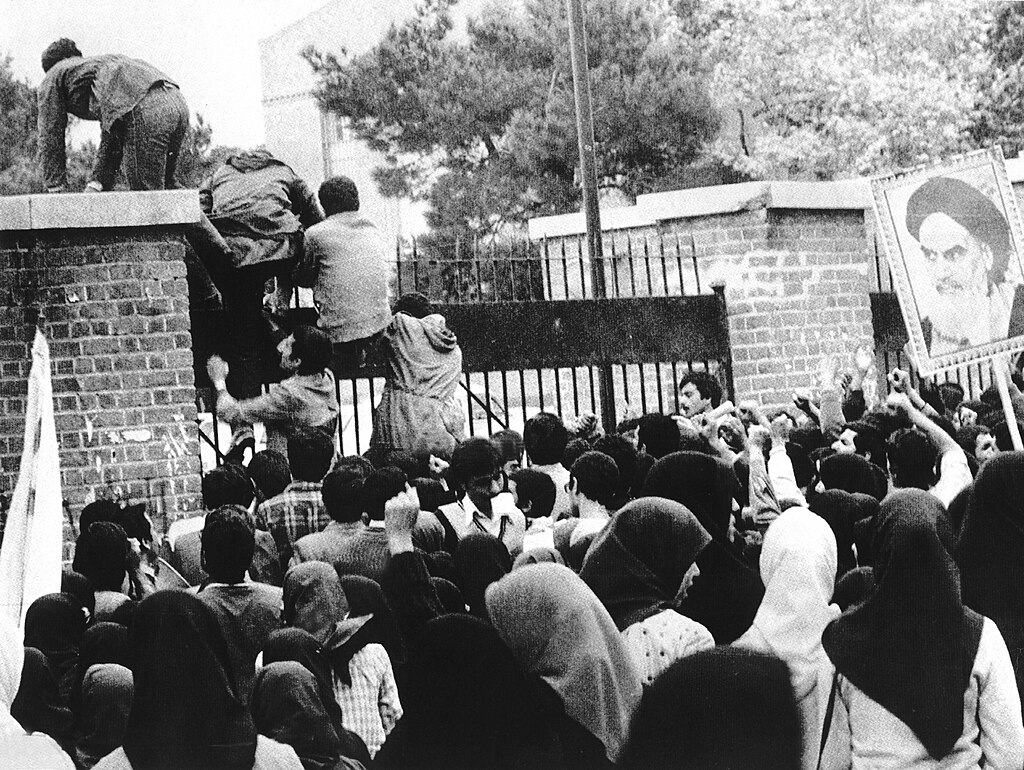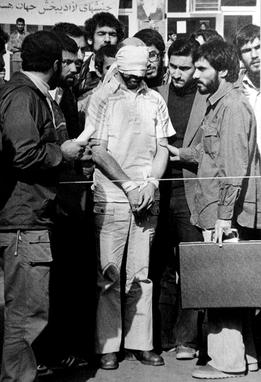General Discussion
Related: Editorials & Other Articles, Issue Forums, Alliance Forums, Region Forums40 Years Ago Today; Iranian students overruns the U.S. embassy in Tehran and takes 90 hostages

Iranian students crowd the U.S. Embassy in Tehran (November 4 1979)
The Iran hostage crisis was a diplomatic standoff between the United States and Iran. Fifty-two American diplomats and citizens were held hostage for 444 days from November 4, 1979, to January 20, 1981, after a group of Iranian college students belonging to the Muslim Student Followers of the Imam's Line, who supported the Iranian Revolution, took over the U.S. Embassy in Tehran.
Western media described the crisis as an "entanglement" of "vengeance and mutual incomprehension." American President Jimmy Carter called the hostage-taking an act of "blackmail" and the hostages "victims of terrorism and anarchy." In Iran it was widely seen as an act against the U.S. and its influence in Iran, including its perceived attempts to undermine the Iranian Revolution and its longstanding support of the Shah of Iran, Mohammad Reza Pahlavi, who was overthrown in 1979.
After Shah Pahlavi was overthrown, he was admitted to the U.S. for cancer treatment. Iran demanded his return in order to stand trial for crimes that he was accused of committing during his reign. Specifically, he was accused of committing crimes against Iranian citizens with the help of his secret police. Iran's demands were rejected by the United States, and Iran saw the decision to grant him asylum as American complicity in those atrocities. The Americans saw the hostage-taking as an egregious violation of the principles of international law, such as the Vienna Convention, which granted diplomats immunity from arrest and made diplomatic compounds inviolable.
The crisis reached a climax after diplomatic negotiations failed to win the release of the hostages. Carter ordered the U.S. military to attempt a rescue mission – Operation Eagle Claw – using warships that included the USS Nimitz and USS Coral Sea, which were patrolling the waters near Iran. The failed attempt on April 24, 1980 resulted in the death of one Iranian civilian, and the accidental deaths of eight American servicemen after one of the helicopters crashed into a transport aircraft. United States Secretary of State Cyrus Vance resigned his position following the failure. Six American diplomats who had evaded capture had been rescued by a joint CIA–Canadian effort on January 27, 1980.
The Shah left the United States in December 1979 and was ultimately granted asylum in Egypt, where he died from complications of cancer at age 60 on July 27, 1980. In September 1980 the Iraqi military invaded Iran, beginning the Iran–Iraq War. These events led the Iranian government to enter negotiations with the U.S., with Algeria acting as a mediator. The crisis is considered a pivotal episode in the history of Iran–United States relations.
Political analysts cited the standoff as a major factor in the continuing downfall of Carter's presidency and his landslide loss in the 1980 presidential election; the hostages were formally released into United States custody the day after the signing of the Algiers Accords, just minutes after American President Ronald Reagan was sworn into office. In Iran the crisis strengthened the prestige of Ayatollah Ruhollah Khomeini and the political power of theocrats who opposed any normalization of relations with the West. The crisis also led to American economic sanctions against Iran, which further weakened ties between the two countries.
<snip>
Takeover

Two American hostages during the siege of the U.S. Embassy.
On November 4, 1979, one of the demonstrations organized by Iranian student unions loyal to Khomeini erupted into an all-out conflict right outside the walled compound housing the U.S. Embassy.
About 6:30 a.m., the ringleaders gathered between three hundred and five hundred selected students and briefed them on the battle plan. A female student was given a pair of metal cutters to break the chains locking the embassy's gates and hid them beneath her chador.
At first, the students planned a symbolic occupation, in which they would release statements to the press and leave when government security forces came to restore order. This was reflected in placards saying: "Don't be afraid. We just want to sit in." When the embassy guards brandished firearms, the protesters retreated, with one telling the Americans, "We don't mean any harm." But as it became clear that the guards would not use deadly force and that a large, angry crowd had gathered outside the compound to cheer the occupiers and jeer the hostages, the plan changed. According to one embassy staff member, buses full of demonstrators began to appear outside the embassy shortly after the Muslim Student Followers of the Imam's Line broke through the gates.
As Khomeini's followers had hoped, Khomeini supported the takeover. According to Foreign Minister Yazdi, when he went to Qom to tell Khomeini about it, Khomeini told him to "go and kick them out." But later that evening, back in Tehran, Yazdi heard on the radio that Khomeini had issued a statement supporting the seizure, calling it "the second revolution" and the embassy an "American spy den in Tehran."

Barry Rosen, the embassy's press attaché, was among the hostages. The man on the right holding the briefcase is alleged by some former hostages to be future President Mahmoud Ahmadinejad, although he, Iran's government, and the CIA deny this.
The occupiers bound and blindfolded the Marines and staff at the embassy and paraded them in front of photographers. In the first couple of days, many of the embassy workers who had sneaked out of the compound or had not been there at the time of the takeover were rounded up by Islamists and returned as hostages. Six American diplomats managed to avoid capture and took refuge in the British Embassy before being transferred to the Canadian Embassy. Others went to the Swedish Embassy in Tehran for three months. In a joint covert operation known as the Canadian caper, the Canadian government and the CIA managed to smuggle them out of Iran on January 28, 1980, using Canadian passports and a cover story that identified them as a film crew.
A State Department diplomatic cable of November 8, 1979, details "A Tentative, Incomplete List of U.S. Personnel Being Held in the Embassy Compound."
</snip>
It was still Nov 3 in the US, a Saturday night. I remember this because they broke into SNL, which was about to start, to announce that the embassy had been overrun.
JimGinPA
(14,811 posts)braddy
(3,585 posts)raid planning, the insistence that it be a combined service operation. The debacle of the Marine helicopter pilots that resulted in the deaths of the Airmen and Marines, led to the Army creating the 160th SOAR (A) helicopter unit.
Boomerproud
(7,943 posts)these hostages down.
superpatriotman
(6,247 posts)That’s right, folks. No deaths. For THIS Iran is considered our mortal enemy. Cui Bono?
Dustlawyer
(10,494 posts)overthrow) the democratically elected government for their oil. BP asked Britain for help because they did not wish to pay for the oil. Britain got the U.S. involved and we had their Prime Minister arrested, convicted in a show trial, and hung.
The Iranians held this grudge after the Shah we installed purged his citizens with secret police.
We started this problem! I do not justify taking the hostages but context is everything!